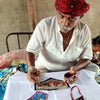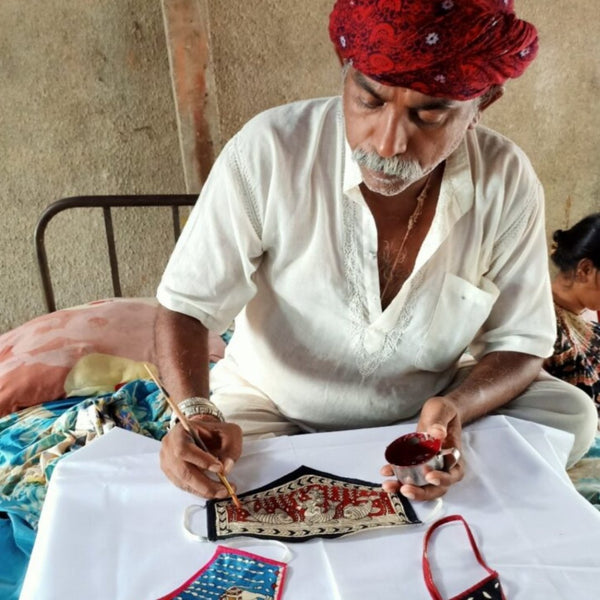Mata
Ni
Pachedi
Mata ni Pachedi is a traditional folk art form from Gujarat, India, known for its vibrant depictions of Hindu goddesses, particularly the mother goddess, Mata. Often referred to as the "Kalamkari of Gujarat," this art form is a unique blend of religious devotion and artistic expression, created by the nomadic Vaghari community. Mata ni Pachedi literally translates to "behind the goddess," as these artworks were traditionally used as backdrops in shrines and temples dedicated to the goddess.
Mata ni Pachedi is characterized by its bold and dynamic compositions, featuring the goddess in the center, surrounded by her devotees, attendants, and symbolic animals. The figures are depicted in a narrative style, telling stories of the goddess's power and benevolence. The color palette is predominantly earthy, with black, red, and white being the primary colors used. The use of these colors is not just aesthetic but also symbolic—red represents the goddess’s strength and power, black symbolizes her protective nature, and white signifies purity.
The design elements in Mata ni Pachedi are intricate, with detailed patterns and motifs that fill the entire canvas. The central figure of the goddess is often larger than the other elements, emphasizing her importance. The borders are usually filled with floral patterns, geometric shapes, and representations of animals that hold symbolic meanings within the context of the artwork.
History
The origins of Mata ni Pachedi can be traced back to the Vaghari community, who were traditionally hunters but later became known for their textile artistry. Due to their marginalized status, the Vagharis were often denied entry into temples. In response, they created portable shrines using cloth paintings that depicted the goddess, allowing them to continue their religious practices. These portable shrines evolved into the Mata ni Pachedi art form we see today, which continues to be an integral part of the community’s spiritual and cultural identity.
Material and Method
Mata ni Pachedi is traditionally created on a cotton cloth using natural dyes. The process begins with the preparation of the cloth, which is first treated with a solution of cow dung and water to make it absorbent. The cloth is then sun-dried before being dyed with a natural color—usually red, which is obtained from tamarind seeds or pomegranate peels.
The outlines of the figures and patterns are drawn using a bamboo stick dipped in a black dye made from jaggery and iron. Once the outlines are complete, the spaces are filled in with color, using dyes derived from natural sources like turmeric for yellow, indigo for blue, and alum for red. The entire process is labor-intensive and requires great skill, particularly in maintaining the consistency of the lines and colors.
Significance
Mata ni Pachedi holds profound cultural and spiritual significance for the Vaghari community. It is more than just an art form; it is a medium through which they express their devotion and connect with the divine. These artworks serve as a portable temple for those who may not have access to permanent religious structures, making the worship of the goddess more accessible.
In addition to its religious importance, Mata ni Pachedi is also a testament to the resilience and creativity of the Vaghari community. Despite being marginalized, they have preserved and passed down this art form through generations, ensuring its survival and relevance in contemporary times. Today, Mata ni Pachedi is recognized as an important part of India’s cultural heritage, appreciated for its artistic beauty as well as its rich historical and spiritual context.
FAQs
Can Mata ni Pachedi art be used in modern interiors?
Yes, Mata ni Pachedi art can be beautifully integrated into modern interiors. Its bold patterns and vibrant colors add a unique cultural touch, making it a stunning focal point in any room, whether displayed as wall art or used as a decorative textile.
Is Mata ni Pachedi art suitable for gifting?
Absolutely! Mata ni Pachedi art makes for a thoughtful and culturally rich gift, especially for those who appreciate traditional Indian art forms. It is perfect for special occasions, religious ceremonies, or as a unique addition to any art collection.
How does purchasing Mata ni Pachedi art support the artisans?
When you purchase Mata ni Pachedi art, you directly support the artisans from the Vaghari community who create these intricate pieces. Your purchase helps sustain their livelihoods and contributes to the preservation of this traditional art form.
![]() Get Upto 10% OFF on purchase of this product.
Get Upto 10% OFF on purchase of this product.
![]() Get upto 10% OFF on Live Workshops when sign up for 2 or more workshops.
Get upto 10% OFF on Live Workshops when sign up for 2 or more workshops.
![]() Get 10% OFF coupon code for Art Kits signing up for Masterclass or Live Workshop.
Get 10% OFF coupon code for Art Kits signing up for Masterclass or Live Workshop.
![]() Earn upto 750 Points on purchase of this product.
Earn upto 750 Points on purchase of this product.





